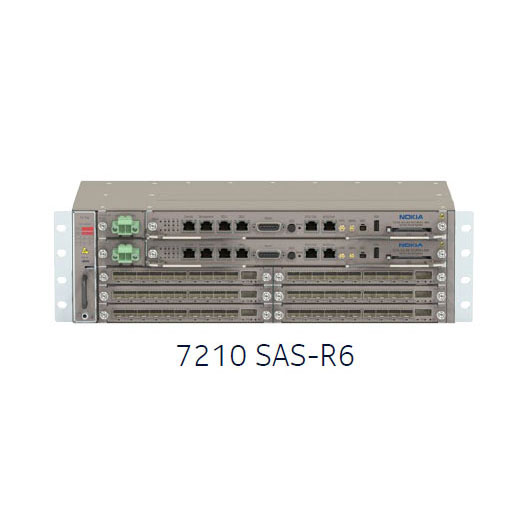Nokia 7210 SAS-R6
Service Access System
The 7210 SAS-R6 router provides up to 100GE line-rate throughput per module slot with 960 Gb/s of system capacity. It has redundant control planes and features non-stop routing and services along with in-service software upgradability.
Nokia 7210 Procuct Family
The Nokia 7210 SAS product family provides service providers with IP routing and Carrier Ethernet demarcation, access, and aggregation for mobile backhaul, business, and residential service delivery. For enterprise and mission-critical network operators, the 7210 SAS addresses stringent requirements for high network resiliency, deterministic network performance, and scalability.
As a member of the Service Router (SR) product portfolio, the 7210 SAS leverages the proven Nokia Service Router Operating System (SR OS) and the Nokia Network Services Platform (NSP) for service and operational consistency across the network. The 7210 SAS is compliant with the Metro Ethernet Forum (MEF) Carrier Ethernet (CE) 3.0 specification, and with Hierarchical Quality of Service (H-QoS) and comprehensive operation, administration, and maintenance (OAM). The 7210 SAS provides deployment flexibility, service richness, and operational simplicity to extend IP/MPLS and Carrier Ethernet services throughout the network.
Features & Benefits
- Service providers want to unlock new revenue streams. Enterprise and mission-critical network operators need to fulfil the specific requirements of each of their various applications. To meet these needs, the 7210 SAS offers differentiated services, including Carrier Ethernet, IP VPN, and enhanced internet services coupled with per-service QoS, and bandwidth guarantees. Service providers can create tiered service models with flexible billing options, tailoring service packages based on the performance and availability requirements of their customers. Enterprise and mission-critical network operators can provide customized QoS and traffic profiles to assure the delivery of individual applications and essential business communications.
Customer satisfaction and application delivery assurance
- The plug-and-play capabilities of the 7210 SAS along with the NSP deliver rapid service turn-up without truck rolls, expediting in-service deadlines and time-to-revenue while minimizing the chance of operator error. The ability to continuously monitor and measure traffic from end to end and troubleshoot proactively enables network problems to be found and resolved before they affect end users. Monitoring, performance measurement of service metrics, prediction of threshold violations, reporting of test results and accurate billing provide a superior level of service to end users. These features also increase the reliability of missioncritical applications. For service providers, self-service customer portals with customized on-demand management capabilities improve the overall quality of experience for their customers.
- Cost savings can be realized by transitioning from separate legacy networks onto a single platform where multiple services are converged onto one uplink and each application can be supported by a full range of Carrier Ethernet and IP/MPLS services. With a variety of compact form factors and features, the 7210 SAS cost effectively scales to support current and future customer and application requirements. It provides savings through advanced QoS, end-to-end OAM, optical integration, streamlined network upgrades, reduced training, testing cycles and operations support system (OSS) integration costs.
Support for differentiated services
Cost reduction through operational simplicity
Software Features
- Layer-2 virtual private network (VPN) services – virtual leased line (VLL) and virtual private LAN service (VPLS)
- IP VPN services (IPv4 and IPv6)
- Ethernet VPN (EVPN) - VPLS - Multi-homing with single active and all-active options.
- Internet Enhanced Service (IPv4 and IPv6)
- Routed VPLS with IES and virtual private routed network (VPRN) IPv4 and IPv6 interfaces
- IPv4 multicast
- IPv4 VPN multicast (Next-generation multicast VPN)
- IEEE 802.1Q (VLAN) and 802.1ad (QinQ)
- Provider Backbone Bridging (PBB), Backbone Edge Bridge (BEB) and Backbone Core Bridge (BCB) as defined in IEEE 802.1ah
- Segment routing – Intermediate System-to-Intermediate System (IS-IS) and Open Shortest Path First (OSPF)
- – Loop-free alternate (LFA) and remote LFA (RLFA)
- Path Computation Element Protocol (PCEP)
- – Resource Reservation Protocol (RSVP) MPLS Label Edge Router (LER) and LSR.
- – MPLS point to multi-point (P2MP) LSPs for NG-MVPN multicast.
- – MPLS-TP (based on IETF standards)
- – Label Distribution Protocol (LDP), LDPv6, LDP over RSVP, and Targeted LDP (T-LDP)
- – Resource Reservation Protocol — Traffic Engineering (RSVP-TE)
- IP routing
- – Intermediate System-to-Intermediate System (IS-IS) (IPv4 and IPv6), including traffic engineering (TE) support for IPv4
- – Open Shortest Path First (OSPFv2 and OSPFv3) with TE support for IPv4
- – IPv4 unnumbered with MPLS
- – Routing Information Protocol (RIP)
- – Border Gateway Protocol (BGP)
- – BGP label unicast routes as defined in RFC 3107 with next-hop-self and Accumulated Interior Gateway Protocol (AIGP) support.
- – BGP-AD for VPLS auto-discovery
- – BGP pseudowire routing for multi-segment pseudowires
- – BGP route-reflector server for VPRN IPv4 and IPv6 routes
- – BGP intra-AS option B for VPRN IPv4 and IPv6 routes
- Protocol Independent Multicast (PIM)
- – Sparse mode (SM), Source Specific Multicast (SSM) and IGMPv1/2/3
- IGMPv1/2/3 snooping
- IEEE 802.3.ad Link Aggregation Group (LAG) and multi-chassis (MC) LAG
- Pseudowire redundancy
- Primary and Secondary LSPs
- Control plane redundancy
- BGP Prefix Independent Convergence (PIC)
- Fast reroute (FRR)
- – LDP with loop-free alternate (LFA) policies
- – RSVP
- – Segment routing with LFA and RLFA
- Equal-cost multi-path (ECMP) load balancing for LDP LSR/LER, IPv4 and L3 VPN tunnels
- Virtual Router Redundancy Protocol and VRRPv3 for IPv6
- Multi-chassis ITU-T G.8032v2
- IEEE Spanning Tree Protocol (STP)/Rapid Spanning Tree Protocol (RSTP)/Multiple Spanning Tree Protocol (MSTP)
- Hardware-based bidirectional forwarding detection (BFD) along with micro-BFD support for LAG with 10ms timer (IPV4 and IPv6)
- Shared Risk Link Group (SRLG) recovery
- Entropy (pseudowire hash) label
- Virtual chassis (stacking)
- Nonstop routing, nonstop services
- In-service software upgrade (ISSU)
- Service ingress packet classification based on MAC and IP criteria (IPv4 and IPv6), MPLS EXP on network ingress
- Service ingress packet classification based on IP DSCP and Dot1p with a large meter pool for higher SAP/service scaling
- Service egress reclassification based on IP DSCP, IP precedence, Dot1p
- Hierarchical per-service ingress and egress policing, queuing, and shaping
- Deep buffering
- RED slope
- Self-generated traffic marking
- Ethernet bandwidth notification (ETH-BN) for transport over microwave links
- IEEE 802.3ah Ethernet in the first mile with Dying Gasp support
- IEEE 802.1ag Ethernet OAM and ITU-T Y.1731 for fault and performance management
- MPLS OAM for in-service performance management (delay, jitter, and packet loss) and fault management
- MPLS-TP OAM
- Service mirroring (local/remote)
- Two-Way Active Measurement Protocol (TWAMP), TWAMP light
- ITU-T Y.1564 test head with multiple streams(with EMIX/IMIX frame-size) and service performance measurement
- Per-port and per-service loopback with MAC-swap
- Link Layer Discovery Protocol (LLDP)
- LLDP Media Endpoint Discovery (MED)
- NETCONF/YANG
- cflowd
- SNMPv1, v2c, v3
- IPv6 for management
- Ethernet and IP tools for performance monitoring with MEF 35-based binning and availability
- PTP-based timestamps for service level agreement measurements
- Remote SR OS upgrade
- Auto-configuration (plug-and-play)
- Configuration roll-back
- Secure Shell (SSH) v4 and v6 for management
- SSH with public key infrastructure (PKI)
- IEEE 802.1x on access ports, MAC and VLAN authentication.
- Control plane security
- Management access filters
- Remote Authentication Dial-In User Service(RADIUS) client
- Terminal Access Concentrator Access Control Server Plus (TACACS+)
- User profile management
- VPLS security
- Access control lists
- Per-port MAC security (MACsec)
- Strict unicast Reverse Path Forwarding (uRPF)
Each product model supports, but is not limited to, a variation of the following features. Please refer to 7210 SAS technical documentation for the features supported on each product
Services
Network protocols
Load balancing and resiliency
Quality of service
OAM
Security







